The Wood Stork (Mycteria americana) is a striking wading bird known for its distinctive appearance and fascinating behaviors.
With its white plumage, bald head, and long, downward-curving bill, the Wood Stork inhabits wetland habitats throughout the Americas.
From its cooperative foraging habits to its elaborate courtship displays, this bird’s ecology and lifestyle offer a captivating glimpse into the intricacies of avian behavior and adaptation.
As a key indicator species for the health of wetland ecosystems, understanding the Wood Stork’s biology and conservation needs is crucial for preserving these vital habitats. So, stay sharp.
Identifying Criteria of Wood Stork
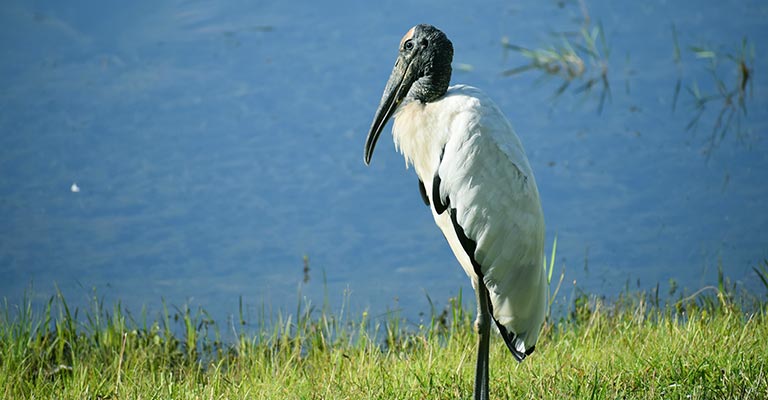
The Wood Stork (Mycteria americana) is a large wading bird found primarily in the southeastern United States, Central America, and northern South America.
Identifying these elegant creatures requires attention to several key characteristics, enabling birdwatchers and enthusiasts to distinguish them from other similar species.
Here are some of the key points to aid in the identification of the Wood Stork:
Size and Shape
Wood Storks are sizable birds, standing around 3.3 to 4.3 feet tall with a wingspan of approximately 5.5 to 6.5 feet.
They have long legs, a long neck, and a distinctive downward-curving bill, giving them a unique silhouette compared to other wading birds.
Coloration
Wood Storks have primarily white plumage covering their bodies, wings, and necks as adults.
However, their heads are bare and dark, appearing almost blackish. Additionally, their wings may show some black flight feathers, particularly visible when the wings are spread.
Bald Head and Neck
One of the most striking features of Wood Storks is their featherless head and neck, which are covered in rough, scaly skin. This feature helps in thermoregulation, allowing the bird to dissipate excess heat.
Bill Shape
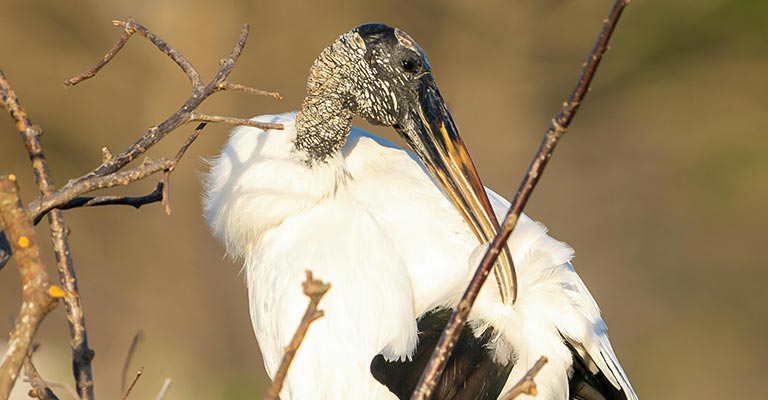
Wood Storks have long, thick bills that curve downward slightly, resembling the shape of a hook.
The bill is dusky in color and often appears darker towards the tip. This unique bill shape is adapted for probing and catching prey in shallow water.
Flight Style
Wood Storks exhibit a distinctive silhouette when in flight, with their long necks and legs extended. They typically fly with slow, steady wingbeats and may soar on thermal updrafts, often holding their necks outstretched.
Behavior
These birds are often seen foraging in groups, wading through shallow waters with their bills submerged, sweeping from side to side to catch prey.
They may also engage in cooperative hunting, forming feeding aggregations with other wading bird species.
Vocalizations
While not always conspicuous, Wood Storks can produce various vocalizations, including croaks, grunts, and bill clattering during courtship and nesting periods. These sounds can help confirm their presence in an area.
Identifying Wood Storks involves observing their size, distinctive coloration, bald head and neck, bill shape, flight style, habitat preferences, behavior, and vocalizations.
By paying attention to these critical characteristics, birdwatchers can confidently distinguish Wood Storks from other wading birds in their natural habitat.
Taxonomy of Wood Stork
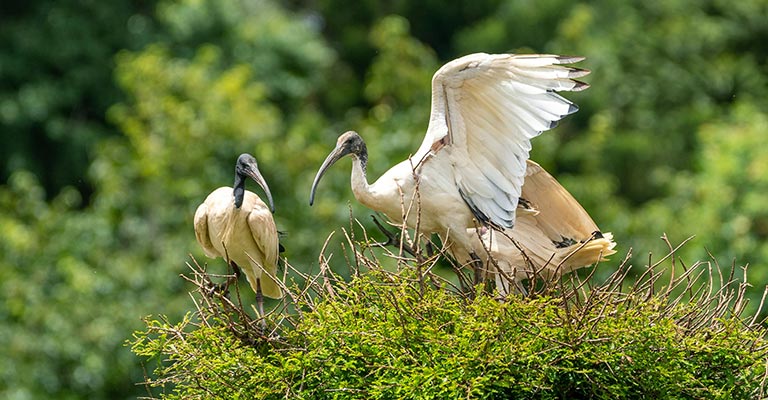
Here’s an excellent table for you detailing the taxonomy of the Wood Stork:
| Domain | Eukaryota |
| Kingdom | Animalia |
| Phylum | Chordata |
| Class | Aves |
| Clade | Aequornithes |
| Order | Ciconiiformes (Bonaparte, 1854) |
| Family | Ciconiidae |
| Genus | Mycteria |
| Species | M. americana |
The Wood Stork (Mycteria americana) belongs to the family Ciconiidae, which comprises large wading birds. Mycteria genus includes six species of storks found across tropical and subtropical regions worldwide.
The species name, Americana, indicates its distribution across the Americas. The Wood Stork falls under the order Ciconiiformes, which encompasses storks, herons, and allies within its taxonomic hierarchy.
This classification reflects its morphological and genetic similarities with other members of the Ciconiidae family, highlighting its evolutionary relationships within the broader avian lineage.
Hunting Habit of Wood Stork
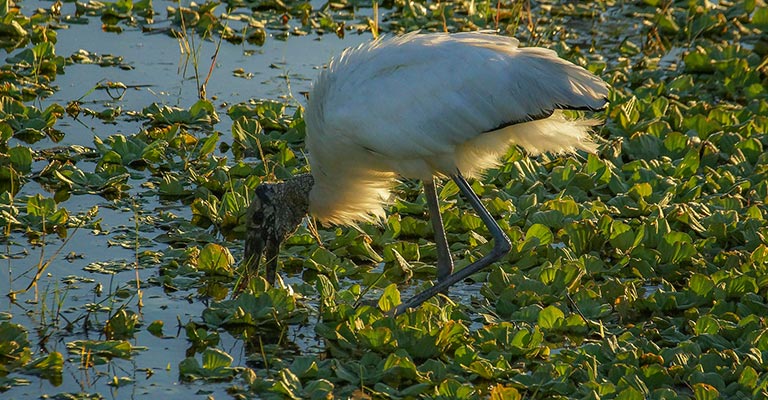
The Wood Stork is a skilled hunter, primarily targeting fish, amphibians, and crustaceans in shallow waters.
Using its long, downward-curving bill, the stork patiently wades through marshes, swamps, and flooded fields, probing the water with its sensitive bill. With a slow, deliberate motion, it sweeps its bill from side to side, feeling for prey.
Once a target is detected, the stork quickly snaps its bill shut, capturing the prey precisely. Often hunting in groups, Wood Storks may engage in cooperative foraging, forming feeding aggregations with other wading bird species.
This social hunting behavior allows them to cover more ground and increase their chances of successful captures.
The Wood Stork’s hunting habit is characterized by patience, precision, and cooperation, enabling it to thrive in its wetland habitats.
Wood Stork Life History
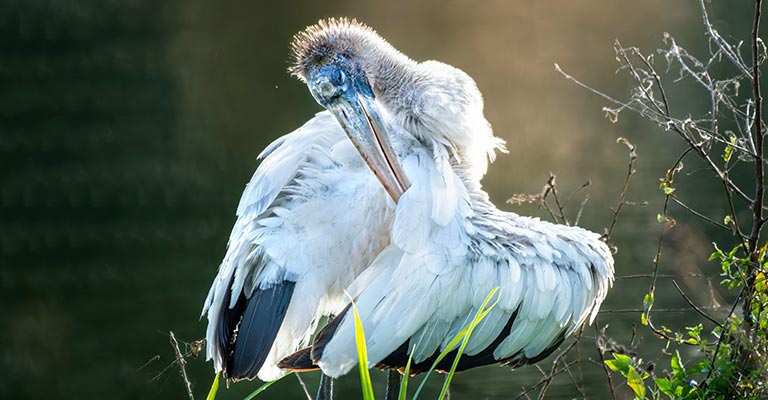
The Wood Stork (Mycteria americana) is a majestic wading bird known for its distinctive appearance and unique behaviors.
Understanding its history provides insight into its ecology, reproduction, and conservation status.
Food
Wood Storks primarily feed on fish, amphibians, and crustaceans, which they catch by wading through shallow waters and using their specialized bill to probe and snatch prey.
Their diet also includes insects, reptiles, and small mammals, making them opportunistic feeders adaptable to various wetland habitats.
Habitat
These birds inhabit freshwater and brackish wetlands such as marshes, swamps, and flooded fields. They prefer shallow, open waters with abundant prey, where they can forage and nest undisturbed.
Range Map
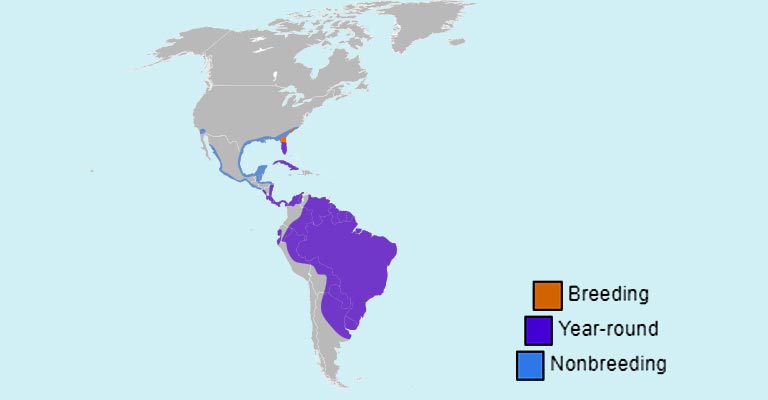
The Wood Stork’s range extends from the southeastern United States, including Florida and the Gulf Coast, through Central America to northern South America.
Breeding populations are primarily concentrated in Florida and coastal areas of the southeastern U.S.
Nesting
Wood Storks nest in large colonies, typically in trees in or near wetlands. They construct bulky stick nests in the canopy, often alongside other wading bird species.
Breeding pairs engage in elaborate courtship displays, including bill-clattering and mutual preening, before laying eggs.
Here’s a comprehensive table detailing the nesting details of the Wood Stork:
| Nesting Details | Description |
| Clutch Size | 2-5 eggs |
| Number of Broods | Typically 1 |
| Egg Length | Approximately 2.5 to 3 inches (6.35 to 7.62 cm) |
| Egg Width | Approximately 1.8 to 2 inches (4.57 to 5.08 cm) |
| Incubation Period | Around 28-32 days |
| Nestling Period | Approximately 56-60 days |
| Egg Description | Whitish with a slightly rough texture |
This table provides a concise overview of the nesting details of the Wood Stork, including clutch size, number of broods, egg dimensions, incubation and nestling periods, and egg description.
Breeding
Breeding occurs during the dry season when water levels in wetlands are lower, concentrating prey and making foraging more efficient. Females lay 2-5 eggs, which both parents incubate for about a month.
Chicks hatch asynchronously and are fed regurgitated food by both parents until they fledge around 60 days old.
Diseases
Wood Storks are susceptible to various diseases, including avian botulism and avian vacuolar myelinopathy, which can impact their health and reproductive success.
Treatment
Conservation efforts aim to monitor and mitigate disease outbreaks through habitat management, disease surveillance, and veterinary care for affected individuals.
Conservation
Wood Storks face threats such as habitat loss, water management practices, and pollution, leading to declines in breeding populations.
Conservation measures include wetland restoration, land protection, and regulatory measures to protect nesting sites.
Understanding the life history of the Wood Stork is essential for implementing effective conservation strategies to ensure the long-term survival of this iconic wetland species.
10 Behavioral Habits of Wood Stork
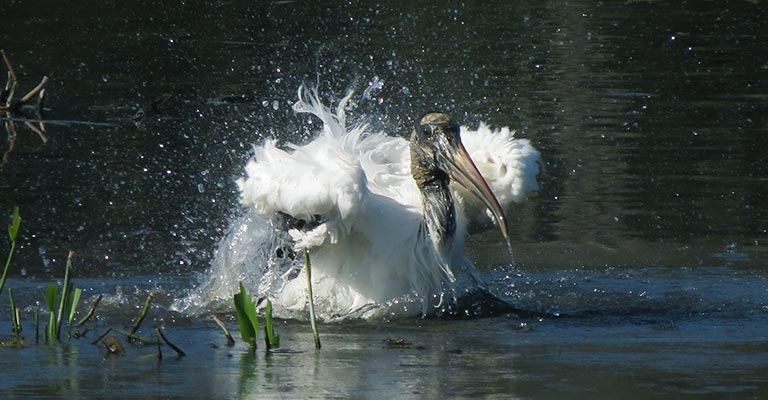
The Wood Stork (Mycteria americana) exhibits a variety of fascinating behavioral habits that contribute to its survival and adaptation in wetland habitats.
Understanding these behaviors provides valuable insight into the ecology and lifestyle of this iconic wading bird.
- Social Foraging: Wood Storks often forage in groups, forming feeding aggregations with other wading bird species. This social behavior allows them to cover more ground and increase their efficiency in capturing prey.
- Cooperative Hunting: Wood Storks may engage in cooperative hunting within feeding aggregations, coordinating their movements to drive prey toward shallower waters where they are more easily captured.
- Wing Spreading: When resting or basking in the sun, Wood Storks frequently spread their wings wide, a behavior known as “sunbathing.” This activity helps regulate body temperature and may also aid in drying their feathers.
- Vocalizations: Wood Storks produce a variety of vocalizations, including grunts, croaks, and bill-clattering sounds. These vocalizations are used to communicate within the colony, during courtship displays, and maintain social cohesion.
- Nesting Colony Formation: During the breeding season, Wood Storks gather in large colonies, often alongside other wading bird species. This communal nesting behavior provides safety in numbers and facilitates mate selection and courtship displays.
- Courtship Displays: Breeding pairs engage in elaborate courtship displays, including bill-clattering, mutual preening, and ritualized movements. These displays strengthen pair bonds and signal readiness to mate.
- Nest Building: Wood Storks construct large stick nests in trees in or near wetlands. Both males and females participate in nest building, reinforcing pair bonds, and establishing territory within the colony.
- Parental Care: Both parents are responsible for incubating the eggs and feeding the nestlings. They regurgitate partially digested food to feed the chicks, ensuring their growth and development.
- Territorial Defense: Breeding pairs defend their nesting territory from intruders, displaying aggressive behaviors like bill-thrusting and wing-flapping to deter potential threats.
- Fledging Behavior: After approximately 56-60 days, the nestlings fledge and begin to explore their surroundings. They may stay close to the nesting site for a period before gradually dispersing to find their foraging grounds.
The behavioral habits of the Wood Stork are diverse and complex, reflecting its adaptation to the dynamic wetland environments it inhabits.
From social foraging and cooperative hunting to nesting colony formation and fledging behavior, these behaviors contribute to this remarkable bird species’ survival and reproductive success.
Wrapping Up
The Wood Stork’s behavioral habits reveal this iconic wading bird’s remarkable adaptability and social dynamics.
From cooperative foraging and intricate courtship displays to diligent parental care and territorial defense, these behaviors are essential for its survival in wetland habitats.
Appreciating the intricacies of Wood Stork behavior not only enriches our knowledge of avian ecology but underscores the importance of conservation efforts to safeguard their habitats and populations for future generations to admire and study. Best of luck.